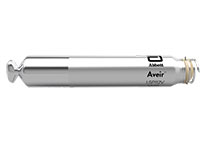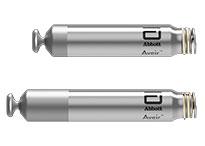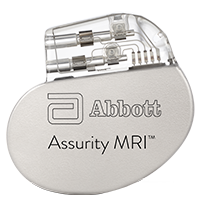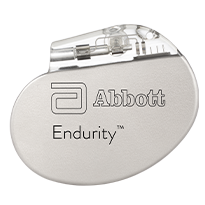Advancements in pacemaker technology have introduced smaller devices, more physiologic shapes, MR Conditional systems, remote monitoring, and increased device longevity. Abbott offers multiple pacemaker options with unique functionality so you and your team can determine the best solution for your patients’ conditions.
AVEIR™ AR2 Atrial Leadless Pacemaker
As the exclusive provider of atrial leadless pacemakers (LPs), Abbott offers a second-generation atrial device, AVEIR AR2 Leadless Pacemaker, with enhanced battery life in the same size, long-term retrievability, and the option to upgrade to dual chamber pacing.1,2
AVEIR™ VR Ventricular Leadless Pacemaker
The AVEIR VR leadless pacemaker is the next evolution in ventricular leadless technology that has been designed for long-term retrieval2, an extended battery life4,5, electrical mapping prior to fixation for optimal device location4,6, and provides an upgradeable platform to later support dual chamber pacing when the patient therapy need evolves.
AVEIR™ DR Dual Chamber Leadless Pacemaker System
The AVEIR DR Dual Chamber Leadless Pacemaker System is a first-of-its kind, dual chamber leadless pacing system featuring both atrial and ventricular pacing and sensing (ex. DDD(R)), beat-to-beat synchrony, an upgradeable system,1 long term retrieval,2 and electrical mapping prior to fixation.1
Assurity MRI™ Pacemaker
The Assurity MRI pacemaker is the longest-lasting compact wireless MRI pacemaker.7*** The longevity of the Assurity MRI pacemaker reduces the chance of potential device replacement, which means less risk for infection and complications.8 No wait 3T and 1.5T MRI options ensure your patients can get the care they need when they need it.
Endurity™ Pacemaker
Designed for ease of implant and a smaller incision and pocket size, the Endurity pacemaker can help reduce RV pacing and heart-failure hospitalization with beat-by-beat ventricular support.9
Powering Hearts Beat to Beat
Sign up to hear about our technology, education opportunities, and more.
Read the Latest Blog Article
Stay up to date with recent news, product highlights, and case studies.
References
* Limited data is available for Aveir LP. The Aveir LP’s predicate device has chronic retrieval success rate >80% with helix fixation through 7 years regardless of implant duration
** ISO standard settings: VVIR, 60bpm, 2.5V @0.4 ms, 600 Ω, 100% pacing
***Among pacemakers < 15cc in total volume; as of February 1, 2017.
- AVEIR™ Leadless Pacemakers and Delivery Catheter IFU, ARTEN600361108.
- Neuzil, Petr, et al. “Worldwide Chronic Retrieval Experience of Helix-Fixation Leadless Cardiac Pacemakers.” Journal of the American College of Cardiology, 2024.
- Knops RE, Ip JE, Doshi R, et al. One-Year Safety and Performance of a Dual-Chamber Leadless Pacemaker. Circulation Arrhythmia and electrophysiology. 2025;18(4):e013619. doi:10.1161/CIRCEP.124.013619
- Aveir™ VR Leadless Pacemaker and Delivery Catheter IFU. ARTEN600349484
- Micra‡ VR IFU M991010A001 REV. B
- Reddy, VY et al. Primary Results on Safety and Efficacy from the LEADLESS II-Phase 2 Worldwide Clinical Trial, JACC: Clinical Electrophysiology, 2021, ISSN 2405-500X, https://doi.org/10.1016/j.jacep.2021.11.002.
- St. Jude Medical. St. Jude Medical Research Report: Competitive Product Review: Wireless Pacemakers. No. 60082151. Rev B.
- Romeyer-Bouchard, C., Da Costa, A., Dauphinot, V., Messier, M., Bisch, L., Samuel, B, ... Isaaz, K. (2010). Prevalence and risk factors related to infections of cardiac resynchronization therapy devices. European Heart Journal, 31(2), 203-210. https://dx.doi.org/10.1093/eurheartj/ehp421
- Faulknier, B., & Richards, M. (2012, December). The association of the use of the ventricular intrinsic preference (VIP™) feature with heart failure hospitalization in pacemaker patients. Presented at the XV International Symposium on Progress in Clinical Pacing, Rome, Italy.
Important Safety Information
Brief Summary: Prior to using these devices, please review the Instructions for Use for a complete listing of indications, contraindications, warnings, precautions, potential adverse events and directions for use.
Aveir Leadless Pacemaker System
Rx Only
Brief Summary: Prior to using these devices, please review the Instructions for Use for a complete listing of indications, contraindications, warnings, precautions, potential adverse events and directions for use.
Indications: The AVEIR™ Leadless Pacemaker system is indicated for management of one or more of the following permanent conditions: Syncope, Pre-syncope, Fatigue, Disorientation. Rate-modulated pacing is indicated for patients with chronotropic incompetence, and for those who would benefit from increased stimulation rates concurrent with physical activity. Dual-chamber pacing is indicated for patients exhibiting: Sick sinus syndrome, Chronic, symptomatic second- and third-degree AV block, Recurrent Adams-Stokes syndrome, Symptomatic bilateral bundle-branch block when tachyarrhythmia and other causes have been ruled out. Atrial pacing is indicated for patients with: Sinus node dysfunction and normal AV and intraventricular conduction systems. Ventricular pacing is indicated for patients with: Significant bradycardia and normal sinus rhythm with only rare episodes of AV block or sinus arrest, Chronic atrial fibrillation, Severe physical disability.
MR Conditional: The Aveir™ Leadless Pacemaker is conditionally safe for use in the MRI environment and according to the instructions in the MRI-Ready Leadless System Manual
Intended Use: The AVEIR™ Leadless Pacemaker (LP) is designed to provide bradycardia pacing as a pulse generator with built-in battery and electrodes for implantation in the right ventricle and/or right atrium. The LP is intended to provide sensing of intrinsic cardiac signals and delivery of cardiac pacing therapy within the implanted chamber for the target treatment group. The LP is also intended to operate optionally with another co-implanted LP to provide dual-chamber pacing therapy.
The AVEIR™ Delivery Catheter is intended to be used in the peripheral vasculature and the cardiovascular system to deliver and manipulate an LP. Delivery and manipulation includes implanting an LP within the target chamber of the heart.
Contraindications: Use of the AVEIR™ Leadless Pacemaker is contraindicated in these cases:
Use of any pacemaker is contraindicated in patients with a co-implanted ICD because high-voltage shocks could damage the pacemaker and the pacemaker could reduce shock effectiveness.
Single-chamber ventricular demand pacing is relatively contraindicated in patients who have demonstrated pacemaker syndrome, have retrograde VA conduction, or suffer a drop in arterial blood pressure with the onset of ventricular pacing.
Programming of rate-responsive pacing is contraindicated in patients with intolerance of high sensor driven rates.
Use is contraindicated in patients with an implanted vena cava filter or mechanical tricuspid valve because of interference between these devices and the delivery system during implantation.
Persons with known history of allergies to any of the components of this device may suffer an allergic reaction to this device. Prior to use on the patient, the patient should be counseled on the materials (listed in the Product Materials section of the IFU) contained in the device and a thorough history of allergies must be discussed.
Adverse Events: Potential complications associated with the use of the AVEIR™ Leadless Pacemaker system are the same as with the use of single or dual chamber pacemakers with active fixation pacing leads including, but not limited to: Cardiac perforation, Cardiac tamponade, Pericardial effusion, Pericarditis, Valve damage and/or regurgitation, Heart failure, Pneumothorax/hemothorax, Cardiac arrhythmias, Diaphragmatic/phrenic nerve stimulation / extra-cardiac stimulation, Palpitations, Hypotension, Syncope, Cerebrovascular accident, Infection, Hypersensitivity reaction to device materials, contrast media, medications, or direct toxic effect of contrast media on kidney function, Pacemaker syndrome, Inability to interrogate or program the LP due to programmer or LP malfunction, Intermittent or complete loss of pacing and/or sensing due to dislodgement or mechanical malfunction of the LP (non-battery related), Loss of capture or sensing due to embolization or fibrotic tissue response at the electrode, Increased capture threshold, Inappropriate sensor response, Interruption of desired LP function due to electrical interference, either electromyogenic or electromagnetic, Battery malfunction/ premature battery depletion, Device-related complications (Premature deployment, Device dislodgement/embolization of foreign material, Helix distortion), Death. As with any percutaneous catheterization procedure, potential complications include, but are not limited to: Vascular access complications; such as perforation, dissection, puncture, groin pain, Bleeding or hematoma, Thrombus formation, Thromboembolism, Air embolism, Local and systemic infection, Peripheral nerve damage. General surgery risks and complications from comorbidities; such as hypotension, dyspnea, respiratory failure, syncope, pneumonia, hypertension, cardiac failure, reaction to sedation, renal failure, anemia, and death.
Assurity MRI
Rx Only
Indications: Implantation is indicated in one or more of the following permanent conditions: syncope, presyncope, fatigue, disorientation due to arrhythmia/bradycardia or any combination of those symptoms. Rate-Modulated Pacing is indicated for patients with chronotropic incompetence, and for those who would benefit from increased stimulation rates concurrent with physical activity. Dual-Chamber Pacing is indicated for those patients exhibiting: sick sinus syndrome, chronic, symptomatic second- and third-degree AV block, recurrent Adams-Stokes syndrome, symptomatic bilateral bundle branch block when tachyarrhythmia and other causes have been ruled out. Atrial Pacing is indicated for patients with sinus node dysfunction and normal AV and intraventricular conduction systems. Ventricular Pacing is indicated for patients with significant bradycardia and normal sinus rhythm with only rare episodes of A-V block or sinus arrest, chronic atrial fibrillation, severe physical disability. AF Suppression algorithm is indicated for suppression of paroxysmal or persistent atrial fibrillation episodes in patients with one or more of the above pacing indications.
Contraindications: Dual-chamber pulse generators are contraindicated in patients with an implanted cardioverter-defibrillator. Rate-Adaptive Pacing may be inappropriate for patients who experience angina or other symptoms of myocardial dysfunction at higher sensor-driven rates. An appropriate Maximum Sensor Rate should be selected based on assessment of the highest stimulation rate tolerated by the patient. AF Suppression™ stimulation is not recommended in patients who cannot tolerate high atrial-rate stimulation. Dual-Chamber Pacing, though not contraindicated for patients with chronic atrial flutter, chronic atrial fibrillation, or silent atria, may provide no benefit beyond that of single-chamber pacing in such patients. Single-Chamber Ventricular Demand Pacing is relatively contraindicated in patients who have demonstrated pacemaker syndrome, have retrograde VA conduction, or suffer a drop in arterial blood pressure with the onset of ventricular pacing. Single-Chamber Atrial Pacing is relatively contraindicated in patients who have demonstrated compromise of AV conduction.
Potential Adverse Events: The following are potential complications associated with the use of any pacing system: arrhythmia, heart block, thrombosis, threshold elevation, valve damage, pneumothorax, myopotential sensing, vessel damage, air embolism, body rejection phenomena, cardiac tamponade or perforation, formation of fibrotic tissue/local tissue reaction, inability to interrogate or program a device because of programmer malfunction, infection, interruption of desired device function due to electrical interference, loss of desired pacing and/or sensing due to lead displacement, body reaction at electrode interface or lead malfunction (fracture or damage to insulation), loss of normal device function due to battery failure or component malfunction, device migration, pocket erosion or hematoma, pectoral muscle stimulation, phrenic nerve or diaphragmatic stimulation. The following, in addition to the above, are potential complications associated with the use of rate-modulated pacing systems: inappropriate, rapid pacing rates due to sensor failure or to the detection of signals other than patient activity, loss of activity-response due to sensor failure, palpitations with high-rate pacing.
Refer to the User’s Manual for detailed indications, contraindications, warnings, precautions and potential adverse events.
Endurity Pacemaker
Rx Only
Indications: Implantation is indicated in one or more of the following permanent conditions: syncope, presyncope, fatigue, disorientation due to arrhythmia/bradycardia or any combination of those symptoms. Rate-Modulated Pacing is indicated for patients with chronotropic incompetence, and for those who would benefit from increased stimulation rates concurrent with physical activity. Dual-Chamber Pacing is indicated for those patients exhibiting: sick sinus syndrome, chronic, symptomatic second- and third-degree AV block, recurrent Adams-Stokes syndrome, symptomatic bilateral bundle branch block when tachyarrhythmia and other causes have been ruled out. Atrial Pacing is indicated for patients with sinus node dysfunction and normal AV and intraventricular conduction systems. Ventricular Pacing is indicated for patients with significant bradycardia and normal sinus rhythm with only rare episodes of A-V block or sinus arrest, chronic atrial fibrillation, severe physical disability. AF Suppression algorithm is indicated for suppression of paroxysmal or persistent atrial fibrillation episodes in patients with one or more of the above pacing indications.
Contraindications: Dual-chamber pulse generators are contraindicated in patients with an implanted cardioverter-defibrillator. Rate-Adaptive Pacing may be inappropriate for patients who experience angina or other symptoms of myocardial dysfunction at higher sensor-driven rates. An appropriate Maximum Sensor Rate should be selected based on assessment of the highest stimulation rate tolerated by the patient. AF Suppression stimulation is not recommended in patients who cannot tolerate high atrial-rate stimulation. Dual-Chamber Pacing, though not contraindicated for patients with chronic atrial flutter, chronic atrial fibrillation or silent atria, may provide no benefit beyond that of single-chamber pacing in such patients. Single-Chamber Ventricular Demand Pacing is relatively contraindicated in patients who have demonstrated pacemaker syndrome, have retrograde VA conduction or suffer a drop in arterial blood pressure with the onset of ventricular pacing. Single-Chamber Atrial Pacing is relatively contraindicated in patients who have demonstrated compromise of AV conduction.
Potential Adverse Events: The following are potential complications associated with the use of any pacing system: arrhythmia, heart block, thrombosis, threshold elevation, valve damage, pneumothorax, myopotential sensing, vessel damage, air embolism, body rejection phenomena, cardiac tamponade or perforation, formation of fibrotic tissue/local tissue reaction, inability to interrogate or program a device because of programmer malfunction, infection, interruption of desired device function due to electrical interference, loss of desired pacing and/or sensing due to lead displacement, body reaction at electrode interface or lead malfunction (fracture or damage to insulation), loss of normal device function due to battery failure or component malfunction, device migration, pocket erosion or hematoma, pectoral muscle stimulation, phrenic nerve or diaphragmatic stimulation. The following, in addition to the above, are potential complications associated with the use of rate-modulated pacing systems: inappropriate, rapid pacing rates due to sensor failure or to the detection of signals other than patient activity, loss of activity-response due to sensor failure, palpitations with high-rate pacing.
Refer to the User’s Manual for detailed indications, contraindications, warnings, precautions and potential adverse events.
MAT-2006955 v6.0 | Item is approved for U.S. use

.png)




